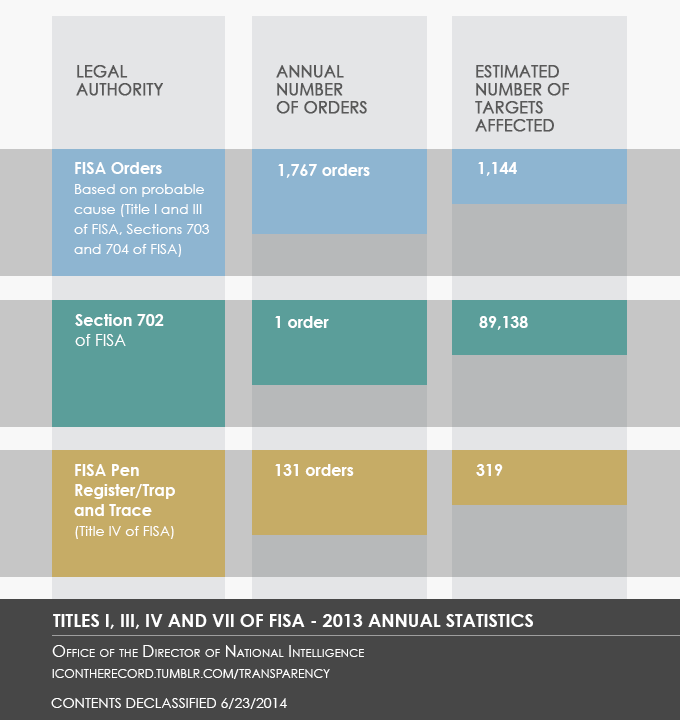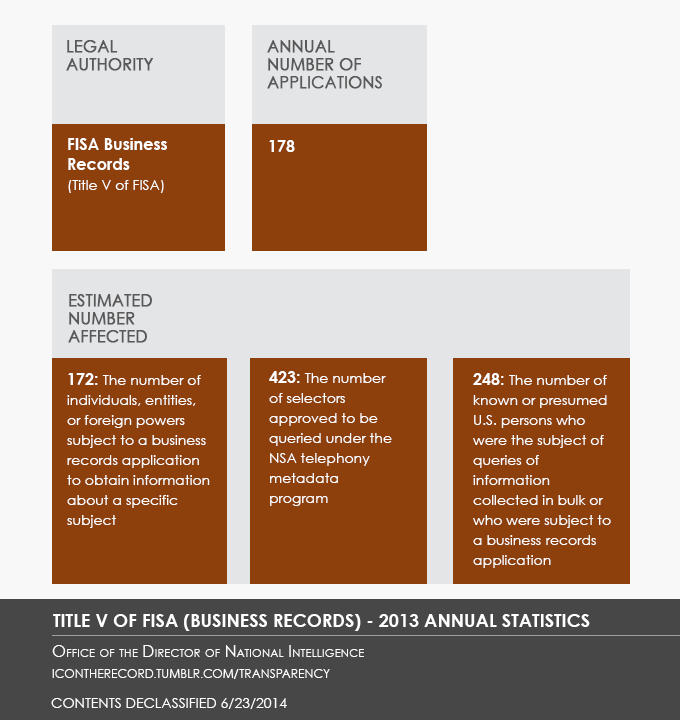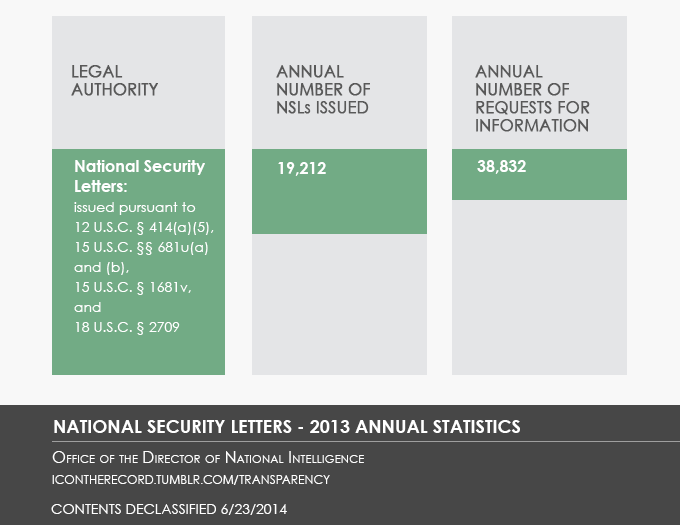Statistical Transparency Report Regarding Use of National Security Authorities - Annual Statistics for Calendar Year 2013
In June 2013, President Obama directed the Intelligence Community to declassify and make public as much information as possible about certain sensitive U.S. Government surveillance programs while protecting sensitive classified intelligence and national security information.
Over the past year, the Director of National Intelligence (DNI) has declassified and authorized the public release of thousands of pages of documents relating to the use of critical national security authorities. Today, and consistent with the DNI’s directive on August 29, 2013, we are releasing information related to the use of these important tools, and will do so in the future on an annual basis. Accordingly, the DNI has declassified and directed the release of the following information for calendar year 2013.
Annual Statistics for Calendar Year 2013 Regarding Use of Certain National Security Legal Authorities
Titles I, III, IV, and VII of FISA

It is important to provide some additional context to the above statistics.
Targets: Within the Intelligence Community, the term “target” has multiple meanings. For example, “target” could be an individual person, a group, or an organization composed of multiple individuals or a foreign power that possesses or is likely to communicate foreign intelligence information that the U.S. government is authorized to acquire by the above-referenced laws.
Some laws require that the government obtain a Court order specifying the communications facilities used by a “target” to be subject to intelligence collection. Although the government may have legal authority to conduct intelligence collection against multiple communications facilities used by the target, the user of the facilities - the “target” - is only counted once in the above figures.
702 Targets: In addition to the explanation of target above, in the context of Section 702 the term “target” is generally used to refer to the act of intentionally directing intelligence collection at a particular person, a group, or organization. For example, the statutory provisions of Section 702 state that the Government “may not intentionally target any person known at the time of the acquisition to be located in the United States” (emphasis added), among other express limitations.
Under Section 702, the Foreign Intelligence Surveillance Court (FISC) approves Certifications as opposed to individualized orders. Thus, the number of 702 “targets” reflects an estimate of the number of known users of particular facilities (sometimes referred to as selectors) subject to intelligence collection under those Certifications. This estimate is based on the information readily available to the Intelligence Community to identify unique targets – users, whose identity may be unknown, but who are reasonably believed to use the particular facility from outside the United States and who are reasonably believed to be non-United States persons.
For example, foreign intelligence targets often communicate using several different email accounts. Unless the Intelligence Community has information that multiple email accounts are used by the same target, each of those accounts would be counted separately in these figures. On the other hand, if the Intelligence Community is aware that the accounts are all used by the same target, as defined above, they would be counted as one target.
Relationship of Orders to Targets: In some cases, one order can by its terms affect multiple targets (as with Section 702). Alternatively, a target may be the subject of multiple orders, as noted below.
Amendments and Renewals: The FISC may amend an order one or more times after it has been issued. For example, an order may be amended to add a newly discovered account used by the target. To avoid redundant counting, these statistics do not count such amendments separately.
Moreover, some orders may be renewed multiple times during the calendar year (for example, the FISA statute provides that a Section 704 FISA Order against a U.S. person target may last no longer than 90 days but permits the order to be renewed). The statistics count each such renewal as a separate order.
Title V of FISA (Business Records)
We are reporting information about the Government’s use of the FISA Business Records provision (Title V) separately because this authority has been used in two distinct ways – collection of business records to obtain information about a specific subject and collection of business records in bulk.
Accordingly, in the interest of transparency, we have decided to clarify the extent to which individuals are affected by each use. In addition, instead of reporting on the number of Business Record orders, the government is reporting on the number of applications submitted to the Foreign Intelligence Surveillance Court because the FISC may issue several orders to different recipients based upon a particular application.

National Security Letters
Finally, we are reporting information on the Government’s use of National Security Letters (NSLs). On April 30, 2014, the Department of Justice released its Annual Foreign Intelligence Surveillance Act Report to Congress. That report, which is available here reports on the number of requests made for certain information concerning different United States persons pursuant to NSL authorities during calendar year 2013.
In addition to those figures, today we are reporting (1) the total number of NSLs issued for all persons, and (2) the total number of requests for information contained within those NSLs. For example, one NSL seeking subscriber information from one provider may identify three e-mail addresses, all of which are relevant to the same pending investigation and each is considered a “request.”
We are reporting the annual number of requests rather than “targets” for multiple reasons. First, the FBI’s systems are configured to comply with Congressional reporting requirements, which do not require the FBI to track the number of individuals or organizations that are the subject of an NSL.
Even if the FBI systems were configured differently, it would still be difficult to identify the number of specific individuals or organizations that are the subjects of NSLs. One reason for this is that the subscriber information returned to the FBI in response to an NSL may identify, for example, one subscriber for three accounts or it may identify different subscribers for each account. In some cases this occurs because the identification information provided by the subscriber to the provider may not be true.
For example, a subscriber may use a fictitious name or alias when creating the account. Thus, in many instances, the FBI never identifies the actual subscriber of a facility. In other cases this occurs because individual subscribers may identify themselves differently for each account, e.g., inclusion of middle name, middle initial, etc., when creating an account.
We also note that the actual number of individuals or organizations that are the subject of an NSL is different than the number of NSL requests. The FBI often issues NSLs under different legal authorities, e.g., 12 U.S.C. § 3414(a)(5), 15 U.S.C. §§ 1681u(a) and (b), 15 U.S.C. § 1681v, and 18 U.S.C. § 2709, for the same individual or organization.
The FBI may also serve multiple NSLs for an individual for multiple facilities, e.g., multiple e-mail accounts, landline telephone numbers, cellular phone numbers, etc. The number of requests, consequently, is significantly larger than the number of individuals or organizations that are the subjects of the NSLs.

This information will be available at the website of the Office of the Director of National Intelligence (ODNI); and ODNI’s public website dedicated to fostering greater public visibility into the intelligence activities of the Government, icontherecord.tumblr.com.